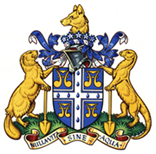
A large party from the Water Conservators headed towards Woolwich for a visit to this marvellous piece of engineering completed in 1982. The need for the barrier was identified in 1953. The visit was arranged to coincide with the planned testing of the operation of the barrier. However, due to the heavy rain in the previous few days and the tidal surge expected shortly, the testing was not required – but we did see the gates in operation.
We impressed ourselves by all arriving early or on time which enabled the early birds to refresh themselves with a coffee in the morning sunshine. At 10.15 exactly we headed off to the bus stop for a short ride to the Barrier Park.
We had time for a brief look at the barrier before we were welcomed at the Visitor Centre by our Guide, Neil, from the Environment Agency. He was a technical expert who gave us a very comprehensive step-by-step account of the need for and history of the Barrier. It cost £735million to build and a replacement would cost about £320billion today. Its location was selected as the river is relatively straight (important for lining up your ship to get through) and there was a good bed of solid chalk on the bottom of the river for construction purposes.
The exceptional high tides had been noted in a Saxon Chronical in 1059; an unusually high tide in 1236 meant you could row across the hall of the Palace of Westminster. In 1663, Samuel Pepys recorded that Whitehall was flooded, and in the flood of 1928 15 lives were lost.
Following the 1953 floods a committee was established to identify options and in 1966 land was purchased for the barrier. After the passing of legislation in 1972 building started in 1974. 41 different designs had been submitted. It became operational in 1982 and since then has operated 231 times to prevent flooding, the last time on 9 April. The gates can be closed in 12 minutes but are normally closed over 1.5 hours to minimise wear. They are 7m high above the datum level at Newlyn.
The gates are operated hydraulically by two rams, each powered by electric pumps between each barrier. There are three uninterruptable power sources to each pump and three back-up generators. The largest gates are 61m wide. 20m high and weigh 3700 tonnes, including 50 tonnes of paint. The barrier is 520m across. There are 33,000 vessel movements through the Barrier each year. It is anticipated that due to the accelerating climate change and rising sea levels a new barrier must be built by 2060, with a new design and location confirmed by 2040. We were not confident that politicians and decision makers will be able to make the necessary decisions on these time scales if past performances are anything to go by.

We then saw a dated video presentation of the building of the barriers and we were warned to watch out for the out-of-date practices, such as the absence of hard hats, smoking at work – and flared trousers. Neil then took us close up to the barrier to see the high water marks on the side of the building. It was a fascinating presentation and we were very grateful to Neil for his time and willingness to engage with us on many different aspects of the working of the barrier. We then returned by bus to the Dial Arch at Woolwich Arsenal for a welcome lunch.
After lunch we walked down to the banks of the Thames to see the extensive developments on the river banks and flood plains. A reminder of the conflict between magnificent riverside development and the loss of flood plains. Another bus ride took us close to the Cutty Sark at Greenwich where we boarded a Thames Clipper Uber Boat for our return to the centre of London and onward journeys home.
A very environmentally friendly day by train, bus and boat.




Post a comment